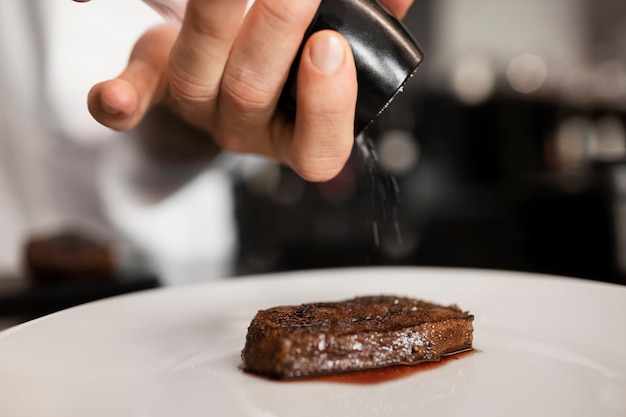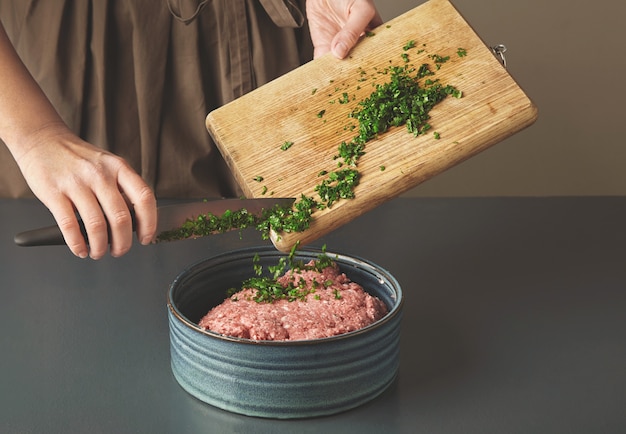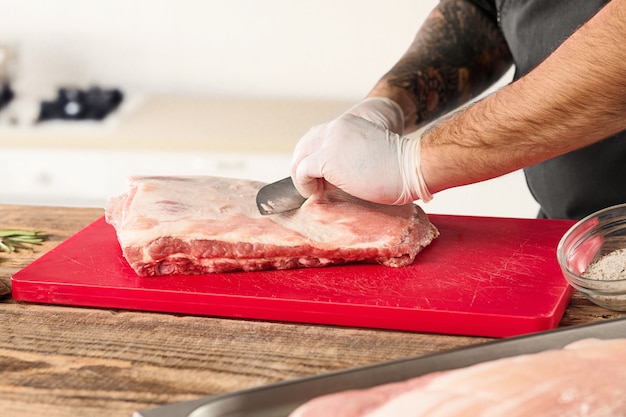Let’s face it, we’ve all been there. You’re craving a juicy, delicious steak, but you forgot to defrost it. Panic sets in, and you’re staring at that frozen brick in your freezer, wondering if it’s even possible to cook a frozen steak without it turning into a rubbery, flavourless disaster. Well, fear not, my fellow steak enthusiasts, because I’m here to tell you: It’s absolutely possible to cook a frozen steak to juicy, flavourful perfection. And I’m going to share with you all the tips and tricks I’ve learned over the years, so you can confidently whip up a delicious steak, even when time is tight.
I used to be a bit of a steak snob, you know? I insisted on only cooking fresh, room-temperature steaks. But over the years, I’ve learned that even a frozen steak can be cooked to perfection with the right techniques. Life gets busy, and sometimes you just don’t have time to plan ahead and thaw your steak overnight. So, let’s dive into the world of frozen steak cooking and discover how to make that frozen brick a culinary triumph.
Part 1: Understanding the Challenges

Why Frozen Steak Can Be Tricky
The main issue with cooking a frozen steak is that the ice crystals inside the meat can disrupt its texture and flavour. As the ice melts during cooking, it creates steam that can escape, leading to a dry, tough steak. Imagine this: those tiny ice crystals are like little bombs going off inside the meat! They disrupt the muscle fibers, making it harder for the steak to hold onto its moisture.
Additionally, the uneven heat distribution from the frozen state can result in overcooked exteriors and undercooked interiors. It’s like trying to cook a steak in a very uneven oven – you’ll get some parts burnt and others still cold.
The Key: Slow and Steady
The secret to successfully cooking a frozen steak lies in a slow and steady approach. By gradually thawing and cooking the steak, we can minimise the negative effects of the ice crystals and achieve a tender, juicy outcome. It’s all about controlling the heat and giving the steak a chance to cook evenly.
Part 2: Selecting the perfect steak

choosing the right cuts
Not all steaks are created equal when it comes to frozen cooking. Thicker cuts like ribeye, new york strip, or even a good-quality sirloin are perfect for this method. These cuts hold up better to the slower cooking process and have enough marbling to stay juicy. Think of it as a steak with a built-in moisture system! Their fat content helps to keep them tender and flavorful even when cooked from frozen.
On the other hand, thinner cuts like flank steak or skirt steak can be more challenging to cook from frozen. They tend to dry out easily, so they’re best reserved for when you have time to thaw them properly.
Frozen steak quality Matters
It’s important to remember that the quality of the frozen steak matters. Just like with any fresh steak, a higher quality cut will yield better results. Look for steaks that are individually wrapped and frozen, and avoid those that have been frozen in bulk. You want to make sure the steak is frozen solid and not showing any signs of freezer burn. If you see any ice crystals on the outside of the packaging or any discoloration on the steak, it’s a sign that it’s been frozen for too long and may not cook well.
Part 3: Getting Ready for Cooking

The Defrost Advantage
While we're focusing on cooking frozen steak, a little defrosting can go a long way. I’m not talking about thawing the steak completely, but rather partially defrosting it for a couple of hours in the refrigerator before cooking. This will help the steak cook more evenly and reduce the amount of time it needs to be on the heat. It’s like giving the steak a head start, so it can warm up and cook more uniformly.
Pat it Dry
Before you start cooking, give your steak a good pat down with paper towels. This will remove any excess moisture and ensure a nice sear on the outside. Think of it as giving the steak a quick “shower” to help it develop a beautiful, crispy crust.
Seasoning Strategies
Seasoning your steak is crucial. I like to salt and pepper my steaks liberally, and I’ve recently been experimenting with some other interesting flavour combinations. For a classic flavour, I’ll use a simple blend of salt, pepper, and garlic powder. For something more adventurous, I’ll try a combination of smoked paprika, onion powder, and cayenne pepper. You can also use pre-made steak seasoning blends or create your own custom blend. The key is to season generously, so the flavors can penetrate the meat and create a delicious crust during cooking.
Part 4: Choosing Your Cooking Method
The Oven: A Gentle Approach
The oven is a great option for cooking frozen steaks because it provides a consistent and gentle heat. I’ll often use the oven method for a large steak, like a ribeye roast. Preheat your oven to 350°F (175°C). Place the frozen steak on a baking sheet lined with parchment paper. I’ll usually place a meat thermometer in the thickest part of the steak to ensure I reach the desired internal temperature. Cook for about 30-45 minutes, depending on the thickness of the steak.
You can check the doneness with a meat thermometer, or use a visual guide to determine how much longer you’ll need to cook it. I recommend using a meat thermometer for accuracy. The steak will continue to cook for a few minutes after you remove it from the oven. This method is perfect for larger steaks, as it allows them to cook slowly and evenly.
The Cast Iron: Searing Power
cast iron skillets are my go-to for searing frozen steaks. They hold heat incredibly well, which is essential for creating a delicious, crispy crust. Heat a heavy cast-iron skillet over medium-high heat for about 5 minutes. Place the frozen steak in the hot skillet and cook for about 5-7 minutes per side, or until a beautiful crust forms. Once you’ve seared the steak, reduce the heat to low and continue cooking, covered, until the steak reaches your desired level of doneness.
You may need to adjust the cooking time depending on the thickness of the steak. The cast iron method is perfect for smaller steaks that you want to cook quickly. The high heat helps to create a flavorful crust while the covered cooking ensures the steak cooks through evenly.
The Grill: Outdoor Delight
If you’re lucky enough to have a grill, it’s a great way to add a smoky flavour to your frozen steak. Preheat your grill to medium-high heat. Place the frozen steak directly on the grill grates and cook for about 6-8 minutes per side, or until a nice sear forms. Once the steak is seared, move it to a cooler part of the grill or turn the heat down to low and continue cooking, covered, until the steak reaches your desired level of doneness.
This method is perfect for those warmer days when you want to enjoy your steak outdoors. The grill adds a unique smoky flavor that’s hard to replicate indoors.
Part 5: Mastering the Doneness
The perfect level of doneness is a matter of personal preference. You’ll find guides that offer recommendations for different levels of doneness based on internal temperature, but remember to always cook your steak to your preferred taste.
Doneness Guide
Here’s a basic guide to different levels of doneness:
| Doneness | Internal Temperature (°F) | Description |
|---|---|---|
| Rare | 125-130°F | Red center, cool to the touch |
| Medium-rare | 130-135°F | Pink center, warm to the touch |
| Medium | 135-140°F | Slightly pink center, warm to the touch |
| Medium-well | 140-145°F | Very little pink, hot to the touch |
| Well-done | 150-155°F | No pink, very hot to the touch |
Part 6: Resting Your Steak
After cooking, give your steak a 5-10 minute rest before slicing and serving. This allows the juices to redistribute, resulting in a more tender and flavorful steak. It’s like giving the steak a chance to relax and regain its composure after the intense heat of cooking. Imagine the steak as a runner who just finished a marathon – it needs a few minutes to catch its breath and recover before it’s ready to be enjoyed.
Part 7: Delicious Accompaniments
A great steak deserves equally great accompaniments. I like to keep things simple with roasted vegetables, a creamy potato gratin, or a classic green salad. But don't be afraid to get creative. There are endless possibilities for delicious side dishes to complement your steak.
For example, you could try a vibrant chimichurri sauce to add a fresh, herbaceous touch, or a tangy béarnaise sauce for a classic French twist. Maybe you’d prefer a side of creamy mashed potatoes or a hearty mushroom risotto. The possibilities are endless!
Part 8: Troubleshooting Frozen Steak
Things don’t always go according to plan, so I thought I’d share some common issues and how to fix them.
Dry Steak
If you find your steak is turning out dry, it's likely because it's been overcooked. The solution? Don't be afraid to reduce the cooking time and check the internal temperature regularly. You can also add a little bit of butter or olive oil to the pan towards the end of cooking, to help retain moisture. Think of it as giving the steak a little bit of a moisture boost.
Uneven Cooking
If the steak is cooking unevenly, it's likely because of inconsistent heat distribution. Make sure your oven is preheated properly, and that your skillet or grill is hot enough. You can also flip the steak more frequently to ensure even cooking. The goal is to maintain a consistent heat source and ensure the steak cooks evenly on all sides.
Tough Steak
A tough steak is usually a sign of overcooking. If you notice the steak is getting too tough, reduce the heat and finish cooking it in the oven. This will allow it to cook more gently and prevent further toughening. Think of it as giving the steak a chance to recover from the intense heat.
Part 9: FAQs
Here are a few questions I get asked a lot about cooking frozen steak.
Can I Cook a Frozen Steak in a Pan?
Absolutely! You can cook a frozen steak in a pan, just like you would a thawed steak. However, you'll need to adjust the cooking time to account for the frozen state. It will likely take longer to cook, and you'll want to watch it carefully to avoid overcooking. Just remember to use a good-quality pan that can handle the high heat and maintain an even temperature.
Can I Cook a Frozen Steak in the Microwave?
It's not recommended to cook a frozen steak in the microwave. While it's a quick way to defrost, it can leave the steak with an uneven texture and dry out the meat. It’s best to avoid using the microwave for cooking steak, as it can lead to an uneven and disappointing result.
Can I Cook a Frozen Steak in the slow cooker?
While you can technically cook a frozen steak in a slow cooker, I don't recommend it. The slow cooking process can actually make the steak tough and dry. It's best to thaw the steak first before using it in the slow cooker. The slow cooker is better suited for tender cuts of meat that require a long, slow cooking time to break down the tough fibers.
Can I Cook a Frozen Steak in the Air Fryer?
You can cook a frozen steak in the air fryer, but it might not be ideal for a thick cut. The air fryer can sometimes result in an unevenly cooked steak, with a dry exterior and undercooked interior. For smaller, thinner cuts, the air fryer can be a good option. Just remember to watch it closely and adjust the cooking time as needed.
How Long Does it Take to Cook a Frozen Steak?
The cooking time for a frozen steak will vary depending on the thickness, cooking method, and desired level of doneness. It can take anywhere from 30 minutes to an hour or more. It’s always best to check the internal temperature with a meat thermometer to ensure the steak is cooked to your liking. The key is to be patient and let the steak cook slowly and evenly, rather than rushing the process.
Conclusion
So there you have it, my comprehensive guide to cooking a frozen steak. Remember, practice makes perfect. Don't be afraid to experiment with different cooking methods and techniques until you find what works best for you. And most importantly, don't be afraid to embrace the occasional frozen steak! It's a culinary adventure waiting to happen.
Everyone is watching

Corn on the Cob: The Ultimate Guide to Perfectly Cooked Ears
Healthy MealsAh, corn on the cob. Just the name evokes images of sunny days, barbecues, and that sweet, juicy flavour that ...

Perfect Pork Roast Oven Cooking Time: A Guide to Delicious Results
Healthy MealsThere's something truly satisfying about a perfectly roasted pork. The aroma alone is enough to make your mout...

Ham Cooking Time: How Long to Bake, Smoke, or Boil a Delicious Ham
Healthy MealsAh, ham. It's a classic, isn't it? A real crowd-pleaser, especially around holidays. And when done right, it'...

Scallops: The Ultimate Guide to Perfect Cooking
Healthy MealsAh, scallops. Those delicate, sweet, and utterly delicious morsels of the sea. They hold a special place in my...

Spaghetti Squash: The Ultimate Guide to Cooking and Serving
Healthy MealsRemember that time you saw spaghetti squash at the supermarket, looking all bumpy and strange, and thought, "W...
